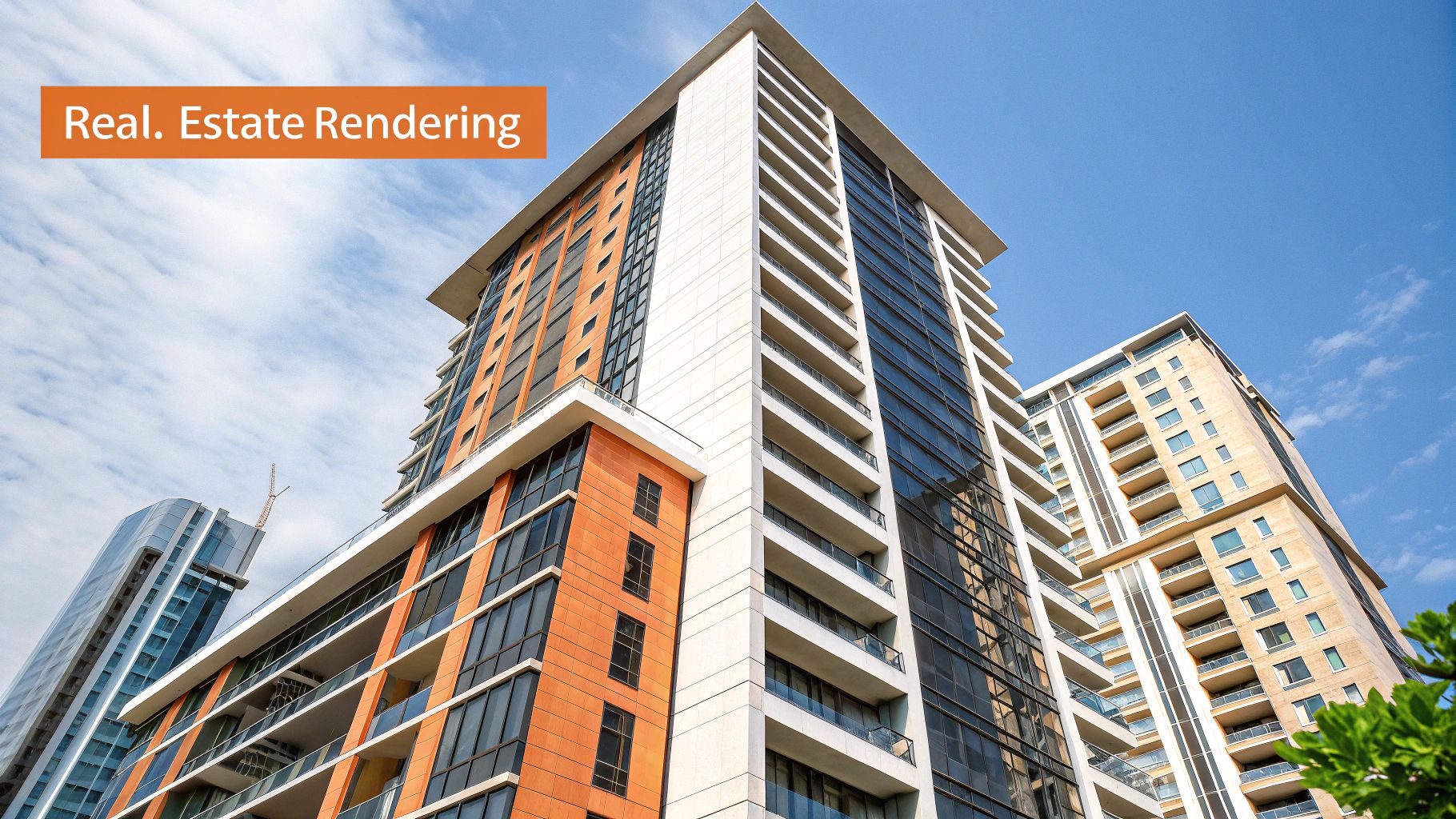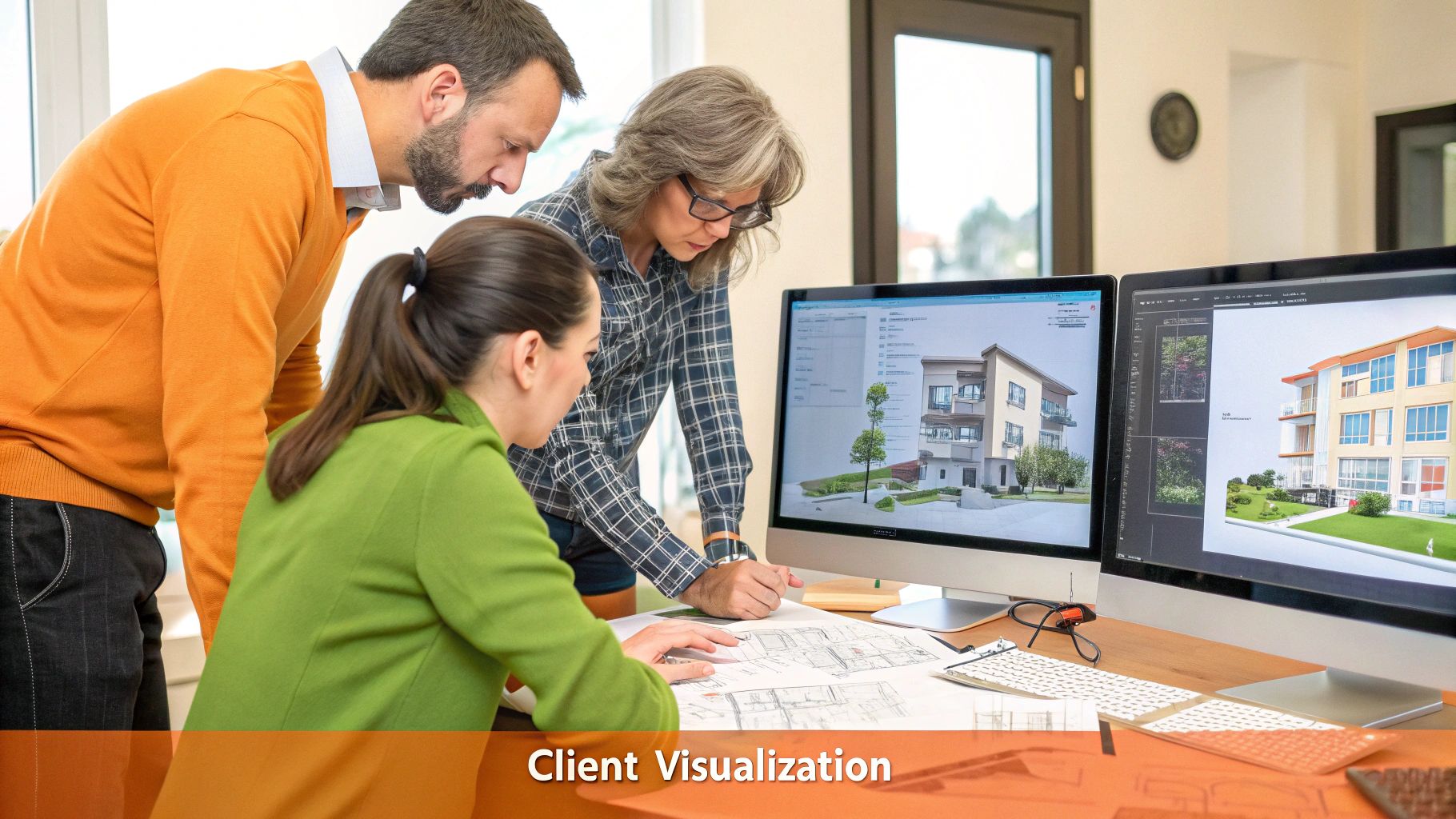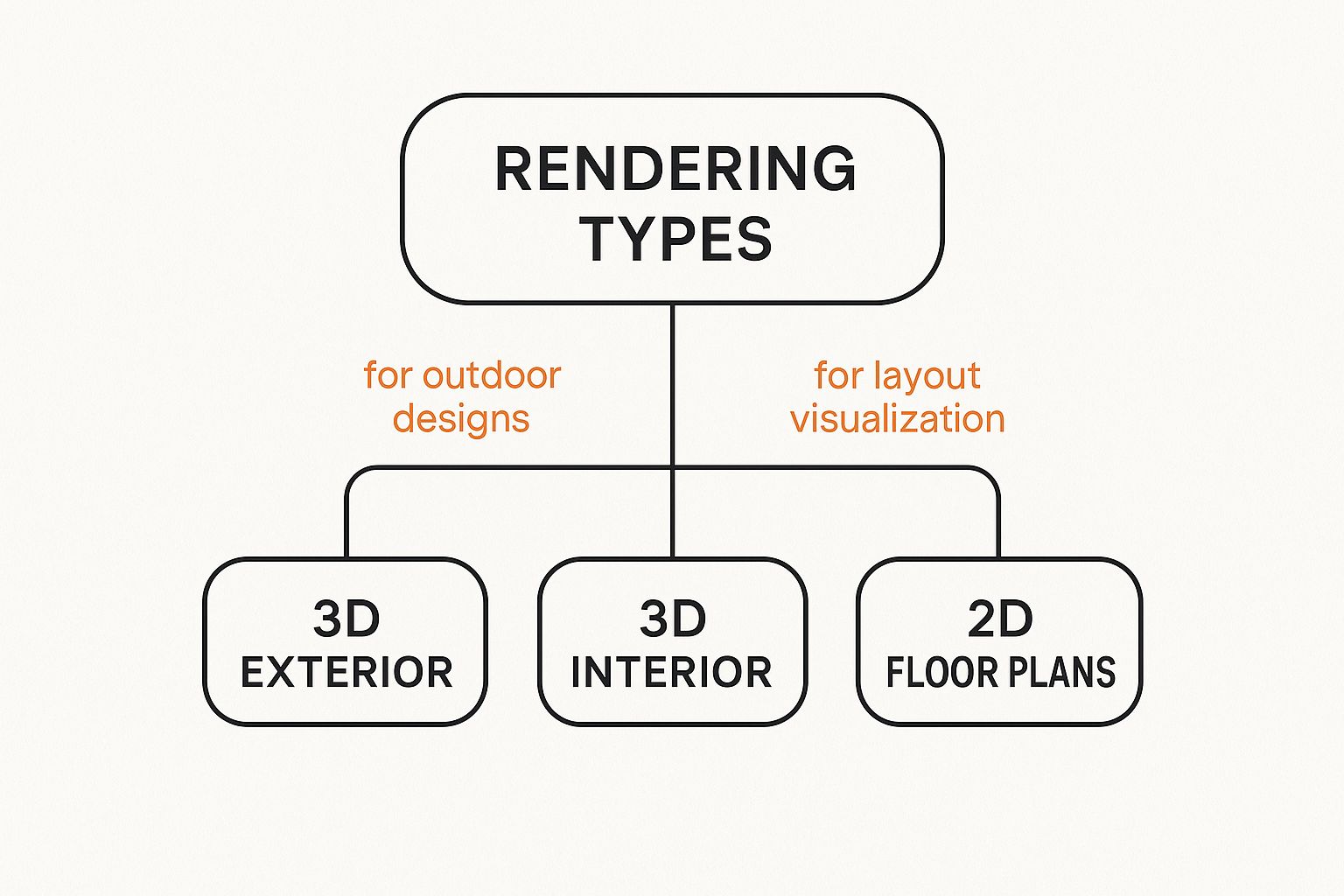A Guide to Real Estate Renderings
Explore how real estate renderings transform properties. This guide covers 3D visualization, key benefits, and AI tools for creating stunning visuals.
Ever tried to get someone excited about a property using just a blueprint? It’s tough. Those technical drawings, full of lines and measurements, just don't capture the feeling of a place. This is where real estate renderings come in—they’re the magic that turns a flat, two-dimensional plan into a stunning, lifelike image.
They act as a bridge between an abstract idea and a tangible vision, making a home that doesn't even exist yet feel real and inviting to potential buyers and investors.
What Are Real Estate Renderings?

Think about it. Selling a dream based on a complex floor plan is a hard sell. Most people simply can't visualize a finished kitchen, a cozy living room, or a building's grand facade from a technical drawing. That’s the exact problem real estate renderings solve so effectively.
These digital images aren't just pretty pictures; they are essential communication tools. They translate an architect’s technical jargon into a universal visual language that anyone can understand and connect with.
Closing the Imagination Gap
At its heart, a rendering closes what I call the "imagination gap." It removes all the guesswork from a project and replaces it with a crystal-clear, photorealistic preview of what’s to come. It’s like the difference between reading a recipe and seeing a photo of the finished dish—one gives you instructions, but the other makes your mouth water. Renderings do the same for property development.
This kind of visual clarity is vital for just about everyone involved in the industry. These aren't just for glossy marketing brochures; they play a key role at every single stage of a property's journey.
The impact is so significant that the architectural visualization market is booming. Projections show it’s on track to hit $5.72 billion by 2025, with 3D rendering accounting for over 75% of that market. You can explore more on this growth in Easy Render's market analysis.
Who Uses Renderings and Why?
The uses for real estate renderings are incredibly varied, helping different professionals hit their unique goals. They are indispensable for:
- Architects and Designers: They use renderings to test out design ideas, catch potential problems early, and show clients exactly what they have in mind. A rendering can instantly confirm if a window placement will catch the morning light perfectly or if a lobby feels as spacious as intended.
- Real Estate Developers: A compelling, tangible vision is key to securing funding. A high-quality rendering can be the final nudge that convinces investors to back a multi-million dollar project because it removes doubt and builds confidence.
- Real Estate Agents and Marketers: Renderings are a game-changer for pre-selling or leasing properties before construction is even finished. By showing off a completed home, agents can forge an emotional bond with buyers, helping them imagine their future in that space and speeding up the sales process.
Common Types of Real Estate Renderings at a Glance
There's a rendering for almost every need. This table gives you a quick rundown of the most common types and what they're best used for in the real estate world.
| Rendering Type | Description | Best For |
|---|---|---|
| Exterior Renderings | Photorealistic images of a property’s exterior, including landscaping, lighting, and surroundings. | Marketing new developments, architectural presentations, and securing project approvals. |
| Interior Renderings | Detailed views of a property’s indoor spaces, showcasing furniture, decor, lighting, and finishes. | Pre-selling homes, interior design planning, and virtual staging for listings. |
| 3D Floor Plans | A top-down, bird's-eye view of a property layout with added depth, texture, and furniture. | Helping buyers understand the spatial flow and layout of a home more easily than a 2D plan. |
| Virtual Tours (360°) | Interactive, panoramic views that allow users to "walk through" a property from their computer or phone. | Creating immersive online experiences for remote buyers and generating qualified leads. |
Each type offers a different perspective, but they all share the same goal: making the property feel real.
By turning abstract plans into images that resonate emotionally, real estate renderings have become a must-have tool for anyone looking to design, fund, or sell a property in today’s market. They make the future visible.
Why Renderings Are Essential for Real Estate Success

So, we know what real estate renderings are, but the bigger question is why they've become so indispensable. In a crowded market, they give you a serious edge, turning abstract architectural plans into something tangible and, frankly, bankable. They're a practical solution for some of the industry's biggest hurdles, from selling properties off-plan to convincing skeptical investors to get on board.
Think of it this way: a blueprint is like sheet music—essential, but only understood by a trained few. A rendering is the full symphony. It translates all that technical data into an emotional experience that anyone can see, feel, and believe in. That one, single image can be the tipping point that turns a "maybe" into a definite "yes" during a multi-million dollar funding pitch.
Accelerate Sales and Secure Funding
One of the biggest wins with real estate renderings is how they can dramatically speed up the sales process. You don’t have to wait for the last nail to be hammered in. Agents can start marketing a fully-realized vision from day one. This is absolutely critical for pre-selling condos in a new tower or leasing commercial space long before the ribbon-cutting ceremony.
When you can show buyers exactly what their future home will look like—right down to the morning sun pouring into the kitchen—you create an instant emotional bond. They aren't just buying square footage; they're buying into a lifestyle.
This power of visual proof is just as potent when you're talking to investors.
A detailed rendering cuts through ambiguity and screams professionalism. It proves a developer has a clear, thought-out vision, which builds confidence and makes the investment feel much less risky to financial backers.
Simplify Complex Approvals and Prevent Errors
Beyond just sales and marketing, renderings are a lifeline for architects and builders. Before a single shovel hits the dirt, a detailed 3D model can help you spot design flaws that would be incredibly expensive to fix later. An architect might notice a structural column that lands awkwardly in an open-plan living room or realize a window’s placement kills any sense of privacy.
Catching these problems in the digital stage saves a massive amount of time, money, and headaches. Renderings also make navigating the approvals process with planning commissions or community boards so much easier. Instead of asking committee members to decipher complex blueprints, you can show them a realistic picture of how the building will look on their street. That clarity alone can sidestep misunderstandings and fast-track the entire approval timeline.
The market itself shows just how much the industry is leaning on this technology. The global 3D rendering market, which includes real estate renderings, was valued at $4.47 billion in 2024 and is projected to soar to nearly $26.65 billion by 2034. That explosive growth is a clear signal that these tools are no longer a novelty but a necessity. You can dive deeper into this trend by checking out these market growth projections from Precedence Research.
Build Powerful and Engaging Marketing Campaigns
At its heart, real estate marketing is about telling a compelling story. A great rendering is the cover of that story—it’s what grabs people’s attention and makes them want to learn more. These stunning visuals quickly become the foundation of your entire marketing strategy, giving you versatile content for every platform.
Here are just a few ways they get put to work:
- Online Listings: Incredible visuals make your property pop on crowded real estate sites, leading to more clicks and serious inquiries.
- Social Media: Those beautiful interior and exterior shots are pure gold for creating shareable content on Instagram and Facebook, helping you reach a much larger audience.
- Print Materials: From high-end brochures to massive construction site hoardings, renderings provide the polished, professional imagery you need to build a premium brand.
While digital visuals offer an amazing preview, they work best when paired with tried-and-true methods. For instance, effective real estate signage is still crucial for grabbing the attention of potential buyers who are physically in the area. By combining powerful digital assets with smart on-the-ground marketing, you create a strategy that covers all your bases. Ultimately, renderings make the unbuilt real, turning a future promise into a tangible opportunity you can act on today.
A Closer Look at Rendering Techniques and Styles
Not all real estate renderings are the same. The term actually covers a whole family of visual styles, and each one has its own specific job to do. Knowing the difference is what separates a good marketing campaign from a great one, ensuring you pick the perfect visual to tell your property's story.
Think of it like choosing a map for a trip. A basic 2D road map is fantastic for getting the big picture, but something like Google Street View gives you a real feel for what it's like to be on that street. Rendering techniques work along a similar spectrum, from simple and functional to deeply immersive.
This graphic gives a nice overview of the main categories you'll run into.

As you can see, renderings can showcase a property from every angle—from its basic layout to its complete interior and exterior personality.
From 2D Floor Plans to 3D Models
The journey usually begins with 2D floor plans. These are the classic, top-down blueprints that clearly show the layout, room sizes, and how the space flows. They’re practical, but they don't exactly scream "home." That's why many professionals now use enhanced 2D plans with added color, textures, and furniture icons to make the layout feel more welcoming and easier to understand.
Next up are 3D floor plans. These give you that same bird's-eye view but with a crucial difference: depth. Walls have height, furniture looks like solid objects, and you get a much clearer sense of the property's actual scale. It's the perfect middle ground, offering more spatial context than a flat plan without needing the full detail of an interior rendering.
But the real magic happens with full 3D renderings. These are the photorealistic images that truly bring a property to life. They don't just show the layout; they capture the atmosphere—the way natural light fills a room, the texture of the materials, and the overall vibe of the space.
Photorealistic vs. Stylized Renderings
Once you're in the 3D world, you have a key artistic choice to make. Getting this right is critical for making sure your visuals hit the right note with your audience.
-
Photorealistic Renderings: The aim here is pure, unadulterated realism. These images are painstakingly crafted to look like actual photographs of the finished property. Artists obsess over every detail, from the subtle reflection in a window to the specific grain of a hardwood floor, to make the viewer believe the space already exists. This style is the gold standard for luxury listings and high-stakes investor pitches where credibility is everything.
-
Stylized or Conceptual Renderings: Sometimes, the goal isn't to perfectly mimic reality but to create a certain mood or feeling. A stylized render might have a soft, watercolor-like finish, use a monochrome color scheme, or incorporate other artistic flairs. This approach is fantastic for early-stage design concepts or marketing campaigns that are selling a specific lifestyle, like tranquility or modern minimalism.
Advanced Formats for Total Immersion
Beyond static images, modern tech offers even more powerful ways to let buyers explore a property. These advanced formats are brilliant for grabbing attention and giving people a level of insight that was impossible just a few years ago.
Virtual Tours (360° Renderings) These are an absolute game-changer, especially for out-of-town buyers. A virtual tour is essentially a series of connected 3D renderings that let you "walk" through a property on your computer or phone. You can look up, down, and all around as you move from room to room, getting a genuine sense of the layout and feel. It’s the next best thing to being there in person.
Aerial and Bird's-Eye Views Let's face it: sometimes a property's best feature isn't inside the walls, but its location. Aerial renderings show the entire property and its surroundings from above. This is a huge help for showcasing a home's large yard, its prime spot near a park or the water, or a commercial building’s easy access to major highways.
Each of these techniques, from a simple 2D plan to a fully interactive virtual tour, has a unique role to play. When you choose the right one, you're not just showing a building; you're turning an architectural vision into a compelling story that connects with your audience.
How to Create High-Impact Real Estate Renderings
Creating truly effective real estate renderings is less about knowing your way around a piece of software and more about telling a compelling story. A great rendering doesn’t just show a space; it makes you feel something. It’s a carefully crafted blend of artistic vision and smart marketing, all designed to make a potential buyer imagine their future life unfolding within those walls.
This process goes far beyond just turning a blueprint into a 3D model. It’s all about making deliberate, creative choices that transform a digital file into an emotionally resonant scene. From the way light streams through a window to the specific decor placed on a coffee table, every single element works together to build an aspirational narrative.
Mastering Light and Shadow for Emotional Depth
If you ask me, light is the most important element in any rendering. It sets the mood, highlights key features, and can make a space feel warm and inviting or sleek and modern. Honestly, mastering light and shadow is what separates a flat, artificial-looking image from one that feels alive and real.
Just think about the difference between the harsh, direct light of a midday sun versus the soft, golden glow of sunset. One feels bright and energetic, while the other feels calm and relaxing. By simply choosing the right time of day for your rendering, you can instantly evoke a specific emotion.
For example, a rendering of a family home’s living room set in the late afternoon, with long shadows and warm light, suggests a cozy, peaceful end to the day. This simple choice helps buyers connect with the feeling of living there, not just the physical layout.
The Art of Digital Staging and Textural Detail
Much like physical home staging, digital staging involves carefully picking out furniture, decor, and accessories to paint a picture of a certain lifestyle. The goal here is to furnish the space in a way that speaks directly to your ideal buyer. A minimalist, high-tech style might attract young professionals to a downtown condo, while a classic, comfortable aesthetic would be a better fit for a suburban family home.
Beyond the big furniture pieces, it’s the small details that really sell the realism. Think about these things:
- Textures: Are the countertops a polished, reflective marble or a rustic, matte butcher block? Does the sofa look like soft linen or rich leather? Realistic textures are what make a scene feel tangible.
- Accessories: A thoughtfully placed stack of books, a vase of fresh flowers, or a steaming mug of coffee can instantly make a house feel like a home. These little details add a layer of authenticity that helps viewers forget they're looking at a render.
- Imperfections: A slightly wrinkled throw blanket or a book left open on a nightstand can make a scene feel more lived-in and natural. A perfectly sterile environment just doesn't feel as welcoming.
Getting this level of detail right is what makes a rendering truly connect with people. For a closer look at how this works in practice, our guide on real estate virtual staging offers more expert insights on furnishing digital spaces to sell.
Rendering Quality Comparison
Not all renderings are created equal. The level of detail, realism, and artistic direction directly influences how potential buyers perceive a property. Below is a quick comparison to help you understand what separates a basic rendering from a high-end, photorealistic one and why it matters for your project's goals and budget.
| Quality Factor | Basic Rendering | High-End Photorealistic Rendering | Impact |
|---|---|---|---|
| Lighting | Simple, uniform lighting, often from a single source. May look flat. | Complex, multi-source lighting with realistic shadows, reflections, and glow. | Determines the mood and emotional appeal; realism makes the space feel tangible and inviting. |
| Textures & Materials | Generic, low-resolution textures. Surfaces may lack realistic depth. | High-resolution, custom textures that accurately mimic real-world materials (wood grain, fabric weave, stone). | High-quality textures make the image believable and convey a sense of luxury and quality. |
| Detail & Staging | Basic, often stock, furniture models with minimal accessories. | Custom-selected, stylish furniture, detailed decor, and "lived-in" elements like books or plants. | Tells a story about the lifestyle, helps target specific buyer demographics, and makes the space feel like a home. |
| Post-Production | Little to no color correction or refinement. | Professional color grading, lens effects, and atmospheric touches to enhance realism. | Polishes the final image, ensuring it is visually stunning and emotionally resonant. |
Ultimately, choosing the right quality level comes down to your audience and objectives. While basic renderings can work for initial planning, high-end photorealistic images are powerful marketing tools that can significantly speed up sales and justify premium pricing.
Collaborating for Perfect Results
To make sure the final real estate renderings align perfectly with your marketing goals, you have to communicate clearly with your rendering artist or agency. Please don't just hand over the blueprints and hope for the best. Instead, provide a detailed creative brief.
Here’s a simple checklist to help guide your collaboration:
- Define the Target Audience: Who are you trying to attract? Describe their lifestyle, tastes, and what they value in a home.
- Establish the Mood: What feeling do you want to convey? Use keywords like "cozy," "luxurious," "serene," or "vibrant."
- Provide a Style Guide: Share a mood board with images of furniture, color palettes, and lighting styles you love.
- Specify Key Features: Point out the architectural details you want to highlight—things like high ceilings, a unique fireplace, or those expansive windows.
When you treat the creation process like a strategic partnership, you ensure every rendering becomes more than just a picture. It becomes a powerful sales tool designed to attract the right buyers and get the job done.
The Future of AI in Real Estate Visualization

The world of real estate renderings is picking up speed, and artificial intelligence is what’s under the hood. The next wave of property visualization isn't just about making prettier pictures. It’s about building smarter, faster, and more compelling ways for people to experience a space long before a single wall goes up. AI is at the very heart of this shift, turning workflows that used to drag on for weeks into tasks that can be wrapped up in minutes.
Think about it: generating a dozen different interior design concepts for one property with just a few clicks. That’s not a far-off dream anymore; it’s happening right now. AI-powered platforms are taking over the heavy lifting of complex and time-consuming jobs like applying textures, staging furniture, and dialing in the perfect lighting. This frees up architects and designers to do what they do best—focus on creative problem-solving and the big-picture vision.
The image above is a perfect example of this tech in action. You start with a simple photo of an empty room, and the AI instantly churns out a fully furnished, professionally staged version. It’s not just dropping furniture into a picture; it’s crafting a cohesive, aspirational lifestyle that a potential buyer can immediately connect with.
Amplifying Creativity, Not Replacing It
A common fear I hear is that AI will put artists and designers out of a job. The reality, however, is much more of a partnership. AI isn't here to replace human creativity; it's here to amplify it.
The best way to think of AI is as an incredibly fast and talented assistant. It can handle the repetitive, technical work, which allows human experts to steer the overall vision and add the final artistic touches that make a rendering truly stand out.
For an architect, this means less time spent on tedious modeling and more time exploring bold design ideas. For a real estate agent, it means being able to offer clients multiple virtual staging options for a listing, right on the spot. This makes high-end visualization accessible to a much wider audience, leveling the playing field for smaller firms and individual agents. You can see how these tools are already being used in our deep dive on AI for real estate.
This evolving relationship between human skill and machine efficiency is completely redefining what’s possible in property marketing and design.
The Rise of Immersive Experiences
Looking beyond static images, the future of visualization lies in total immersion. Virtual Reality (VR) and Augmented Reality (AR) are becoming essential tools, and AI is the key to making them more realistic and accessible than ever before.
-
Virtual Reality (VR): This technology lets a potential buyer pop on a headset and "walk through" a fully rendered, unbuilt property from anywhere in the world. They can feel the scale of the rooms, check out the views from the windows, and get a genuine sense of the home’s flow.
-
Augmented Reality (AR): AR works a bit differently by layering digital information onto the real world. Imagine a buyer visiting an empty construction site. Using their phone, they could see a full-scale 3D model of the finished building standing right in front of them, perfectly aligned with its future foundation.
These technologies are transforming property tours from something you passively watch into an active, engaging experience. When a client can visualize themselves in a space with that much realism, it forges a powerful emotional connection that static images just can't replicate.
The market is clearly moving in this direction. The global 3D architectural rendering services market, a huge piece of the real estate renderings puzzle, was valued at roughly $5 billion in 2025. Fueled by these new technologies, it's expected to jump past $15 billion by 2033, growing at a compound annual rate of 15%. This explosive growth shows just how vital these visualizations have become.
Ultimately, AI is making the creation of real estate renderings and virtual experiences faster, more accessible, and far more powerful. It gives professionals the tools to bring their visions to life with stunning clarity, helping clients make one of the biggest decisions of their lives with true confidence.
Common Questions We Hear About Renderings
If you're new to the world of real estate renderings, you probably have a few questions. That's completely normal. Whether you're a developer mapping out a new skyscraper or an agent trying to pre-sell a home that hasn't been built yet, you need clear answers to make the right moves.
Let's break down some of the most common questions we get, with practical, no-fluff answers.
What’s a Rendering Going to Cost Me?
There’s really no simple answer here, because the cost is tied directly to how complex the image is. It’s a bit like commissioning a piece of art—a quick charcoal sketch won't cost the same as a massive, detailed oil painting.
For a very basic interior shot, you might be looking at a few hundred dollars. But for a highly detailed exterior of a large commercial building, complete with realistic landscaping and dramatic lighting, the price can easily run into the thousands.
What drives the price up?
- Level of Detail: Is this a simple, conceptual look, or a photorealistic image with custom textures and perfect staging? The more detail, the more it costs.
- Project Scale: Creating a single room is one thing. Building a visual for an entire multi-story complex or a sweeping aerial view is a whole different ball game.
- Number of Revisions: Most artists or agencies will include one or two rounds of changes in their quote. If you need more tweaks after that, you can expect the cost to go up.
The best thing you can do is ask for a custom quote. A good rendering professional will want to see your architectural plans and hear about your vision. That way, they can give you a precise price for exactly what your project needs.
How Long Does It Take to Get a Rendering?
Just like cost, the timeline depends entirely on the project's scope. A standard, high-quality still image of an interior or exterior usually takes anywhere from a few days to a couple of weeks.
More involved projects, of course, take longer. A full 360° virtual tour or a detailed aerial rendering that shows the entire neighborhood could take several weeks from the first conversation to the final file delivery.
The process usually looks something like this:
- Kick-off and Quote: You define what you need.
- 3D Modeling: The artist builds the digital structure from your blueprints.
- Textures & Lighting: They add the materials, colors, and lighting to set the mood.
- Draft Review: You get a first look and provide your feedback.
- Final Polish: They create the final high-resolution image and add the finishing touches.
The secret to keeping things on schedule? Be ready with clear, detailed feedback during the review stages. Fast, decisive communication is the quickest path to getting a final image you absolutely love.
Which Type of Rendering Should I Choose?
The right rendering for you depends completely on your goal. Are you trying to sell a condo, get a loan, or win over a planning board? Your main objective will point you to the perfect visual format.
Think of it this way:
- For Pre-Selling Homes: Interior renderings are king. They let buyers walk through the finished spaces in their minds and imagine their furniture in the room. Pair them with a 3D floor plan so they can also understand the layout and flow.
- For Securing Investor Funding: Exterior renderings make a powerful first impression. They sell the architectural vision. An aerial rendering is also a huge asset here, as it shows off the property's scale and prime location.
- For Gaining Design Approvals: You can often get by with clear 2D floor plans and basic exterior renderings. The goal is clarity, not marketing polish. These visuals give planning boards the straightforward information they need.
- For Reaching Out-of-Town Buyers: Nothing beats a 360° virtual tour. It’s an immersive experience that lets someone explore the entire property from their laptop, giving them a real feel for the space without ever stepping inside.
In the end, the strongest marketing packages often mix and match different rendering types to tell a complete and compelling story.
Ready to create stunning, AI-powered visuals for your properties in minutes? With Pedra, you can generate high-impact real estate renderings, virtual staging, and property videos with just one click. Join over 20,000 real estate pros who are closing deals faster. Start creating with Pedra today!

Related Posts
3D Photography for Real Estate Guide
Explore our guide to 3D photography for real estate. Learn how immersive virtual tours can attract q...
Effective Copywriting for Real Estate to Sell Homes Fast
Discover expert copywriting for real estate that boosts property sales. Learn tips to craft compelli...
Top Floor Plan Creator Software of 2025 | Design with Ease
Explore the best floor plan creator software of 2025. Find intuitive tools and powerful features to ...